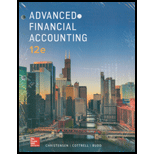
Concept explainers
a.
Concept Introduction:
Business Combination: It is a process where two entities combine their assets and liabilities to form a new third entity to take up the benefit of synergies with legal consent.
To Explain: Journal entries that P should have entered on its books to record the business combination.
a.
Explanation of Solution
Following
| Particular | Debit ($) | Credit ($) | |
| Merger Expense | |||
| To Cash | |||
| (Being legal fees paid.) | |||
| Deferred Stock Issue Cost | |||
| To Cash | |||
| (Being common stock purchased.) | |||
| Cash | |||
| Inventory | |||
| Long Term Investments | |||
| Land | |||
| Rolling Stock | |||
| Plant and Equipment | |||
| Patents | |||
| Special Licenses | |||
| Discount on Equipment trust notes | |||
| Discount on Debentures | |||
| Goodwill | |||
| To Current Payables | |||
| To Mortgages Payable | |||
| To Premium on Mortgages Payable | |||
| To Equipment Trust Notes | |||
| To Debentures Payable | |||
| To Common Stock | |||
| To Additional Paid-in capital | |||
| To Deferred Stock Issue Costs | |||
| (Being legal fees paid) | |||
| Total |
Computation of Goodwill:
Value of stock issued:
Fair value of assets acquired:
Fair value of liabilities acquired:
Goodwill:
b.
Concept Introduction:
Business Combination: It is a process where two entities combine their assets and liabilities to form a new third entity to take up the benefit of synergies with legal consent.
To Explain: Journal entries that should have been entered on S’s books to record the combination and the distribution of the stock received.
b.
Explanation of Solution
Following journal entry would be recorded:
| Particular | Debit | Credit | |
| Investment account | |||
| Allowance for | |||
| Current Payables | |||
| Mortgages payable | |||
| Equipment Trust Notes | |||
| Debentures Payable | |||
| To Discount on Debentures Payables | |||
| To Cash | |||
| To Accounts Receivable | |||
| To Inventory | |||
| To Long Term Investments | |||
| To Land | |||
| To Rolling Stock | |||
| To Plant and Equipment | |||
| To Patents | |||
| To Special Licenses | |||
| To Gain on sale of assets and liabilities | |||
| (Being asset purchased.) | |||
| Common Stock | |||
| Additional paid in Capital-common stock | |||
| To Treasury Stock | |||
| (Being common stock purchased.) | |||
| Common Stock | |||
| Additional Paid-in Capital-Common | |||
| Additional Paid-in Capital-Retirement Preferred | |||
| Retained Earnings | |||
| To Investment account | |||
| (Being purchase of common stock.) | |||
| Total | 7409700 | 7409700 |
Common Stock
Additional paid in capital
Want to see more full solutions like this?
Chapter 1 Solutions
ADVANCED FINANCIAL ACCT.(LL) >CUSTOM<
- Please provide the correct answer to this general accounting problem using accurate calculations.arrow_forwardSummit Technologies has income from operations of $150,000, invested assets of $1,200,000, and sales of $2,500,000. Use the DuPont formula to compute the rate of return on investment, and show: (a) the profit margin (b) the investment turnover (c) the rate of return on investmentarrow_forwardMarvatek Ltd. estimates its factory overhead costs to be $45,600 and machine hours to be 6,000 for the year. If the actual hours worked on production total 5,700 and the actual factory overhead costs are $44,000, what is the amount of the over- or under-applied factory overhead?arrow_forward
- I want the correct answer with general accounting questionarrow_forwardPlease explain how to solve this financial accounting question with valid financial principles.arrow_forwardA firm has a market value equal to ns book value Currently, the firm has excess cash of s800, other assets of $5.200, and equity of $6.000 The firm has 600 shares of stock outstanding and a net income of $500. The firm has decided to spend half of its excess cash on a share repurchase program How many shares of stock we be outstanding after the stock repurchase is completed? What is the Answer?arrow_forward
- Horizon Electronics Inc. uses a standard cost system that applies overhead toarrow_forwardLumen would estimate fixed costdarrow_forwardThe Parker Corporation reported sales revenue of $750,000 during the year. The beginning accounts receivable balance was $35,000, and the ending accounts receivable balance was $40,000. What amount of cash was collected from customers during this period? A. $750,000 B. $755,000 C. $745,000 D. $5,000arrow_forward

 AccountingAccountingISBN:9781337272094Author:WARREN, Carl S., Reeve, James M., Duchac, Jonathan E.Publisher:Cengage Learning,
AccountingAccountingISBN:9781337272094Author:WARREN, Carl S., Reeve, James M., Duchac, Jonathan E.Publisher:Cengage Learning, Accounting Information SystemsAccountingISBN:9781337619202Author:Hall, James A.Publisher:Cengage Learning,
Accounting Information SystemsAccountingISBN:9781337619202Author:Hall, James A.Publisher:Cengage Learning, Horngren's Cost Accounting: A Managerial Emphasis...AccountingISBN:9780134475585Author:Srikant M. Datar, Madhav V. RajanPublisher:PEARSON
Horngren's Cost Accounting: A Managerial Emphasis...AccountingISBN:9780134475585Author:Srikant M. Datar, Madhav V. RajanPublisher:PEARSON Intermediate AccountingAccountingISBN:9781259722660Author:J. David Spiceland, Mark W. Nelson, Wayne M ThomasPublisher:McGraw-Hill Education
Intermediate AccountingAccountingISBN:9781259722660Author:J. David Spiceland, Mark W. Nelson, Wayne M ThomasPublisher:McGraw-Hill Education Financial and Managerial AccountingAccountingISBN:9781259726705Author:John J Wild, Ken W. Shaw, Barbara Chiappetta Fundamental Accounting PrinciplesPublisher:McGraw-Hill Education
Financial and Managerial AccountingAccountingISBN:9781259726705Author:John J Wild, Ken W. Shaw, Barbara Chiappetta Fundamental Accounting PrinciplesPublisher:McGraw-Hill Education





